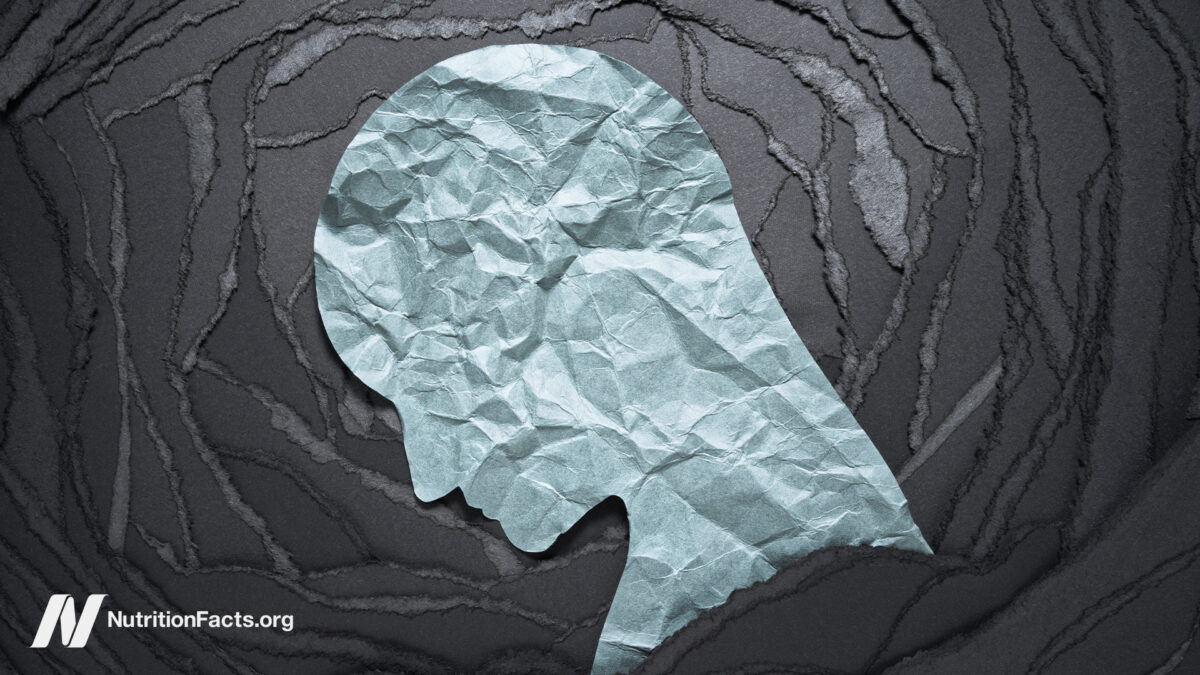The Best Pranayama Techniques for Balancing Your Doshas
The functional principles of Vata, Pitta, and Kapha help us understand ourselves and the universe by acting as energetic forces of nature. Each of these doshas performs a specific set of tasks in the body. These three doshas are...
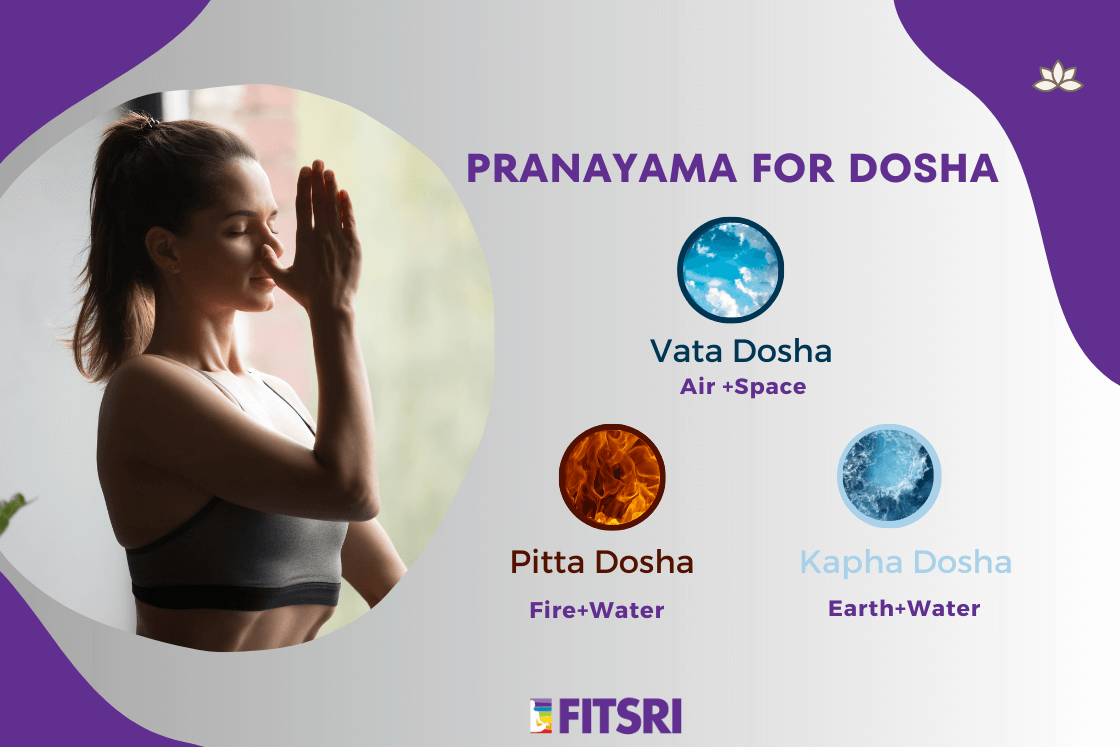
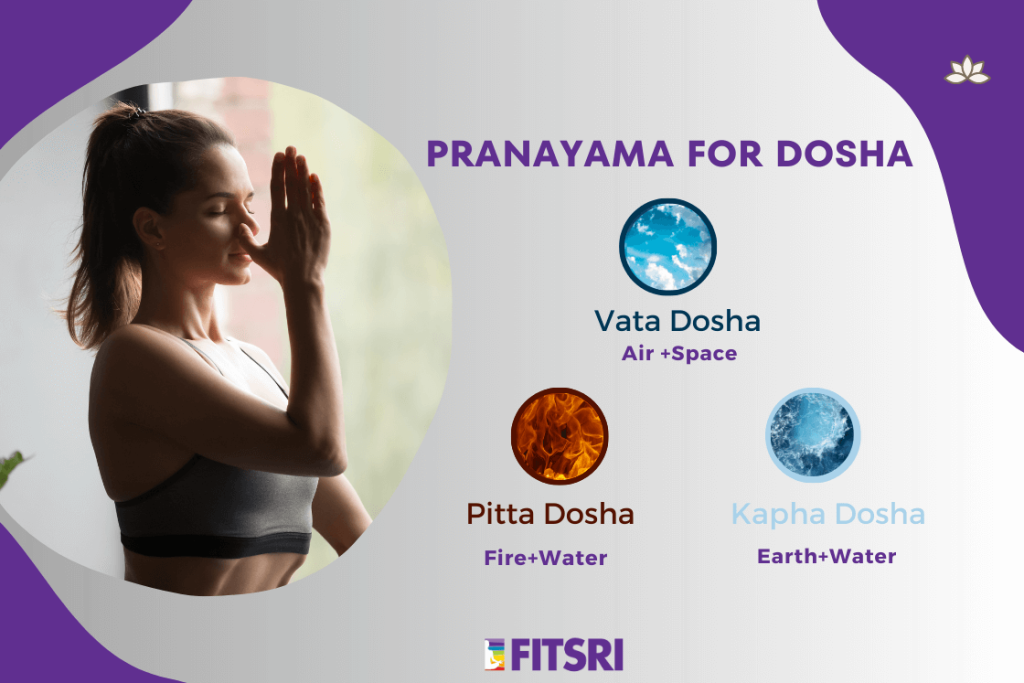
The functional principles of Vata, Pitta, and Kapha help us understand ourselves and the universe by acting as energetic forces of nature. Each of these doshas performs a specific set of tasks in the body. These three doshas are fundamental to the Ayurvedic treatment system as a whole.
Each of us has a unique ratio of Vata, Pitta, and Kapha that serves as a guide to good health. Generally speaking, when a dosha is out of balance, we can restore balance by reducing the effects of the imbalanced dosha’s properties.
By being aware of the specific qualities that are aggravating, we can target the opposing qualities through meal, herbal, and lifestyle choices.
One lifestyle choice that can help restore balance is the practice of pranayama. Pranayama involves mindful awareness of the breath, which is a fundamental aspect of yoga. The life energy, prana, energizes and relaxes the body and mind. Pranayama is even more effective when performed in accordance with one’s body type (dosha). Harmony and balance can be achieved by choosing a breathing technique that embodies the opposing qualities of a particular dosha.
Since each dosha has different qualities, pranayama practice should also be tailored to those qualities. For example, the pitta dosha is typically associated with fire and heat. Therefore, pranayama practice should focus on keeping this heat under control and maintaining optimal body temperature.
With this in mind, we have listed some pranayamas for each dosha that can help reduce dosha imbalances.
Pranayama for Vata Dosha
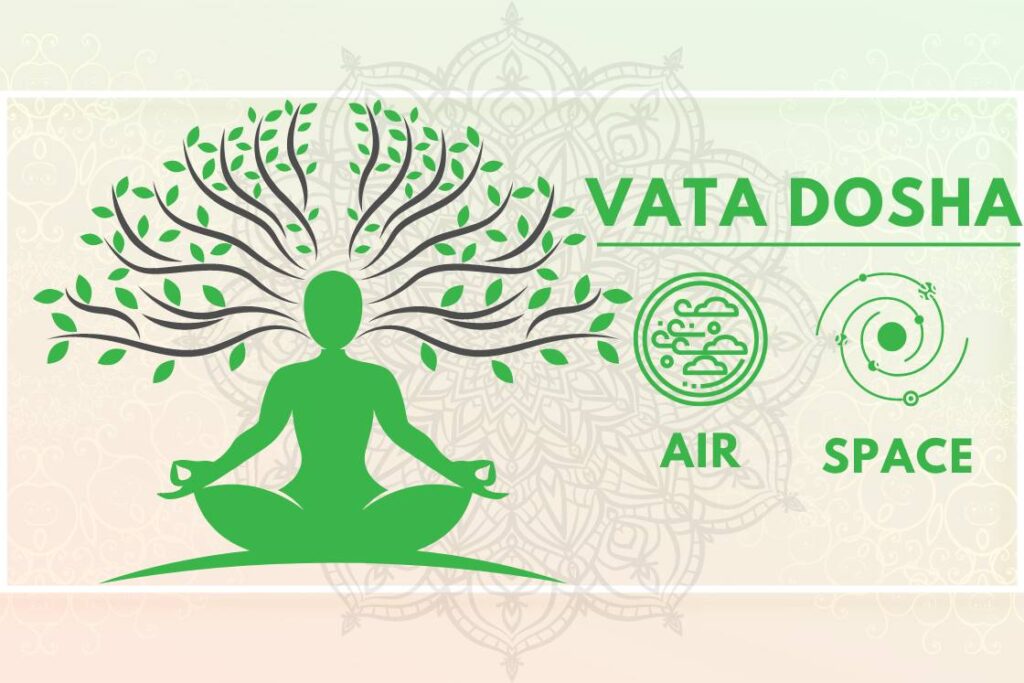
It is also called the king of all doshas because it is considered an essential component of our well-being.
The Vata dosha is responsible for the functioning of the body and mind. It supports a person’s cognitive abilities to interpret information, maintain mental balance, and achieve sensory balance on a mental level.
Compared to the other two doshas, the vata dosha is more prone to imbalances. Problems such as bloating, gas, and respiratory problems are more common because the Vata dosha is primarily composed of the elements of air and space. When your vata level is high, your coordination can suffer as you can lose the connection between prana, mind and body.
For Vata dosha, Pranayama is generally very beneficial to achieve balance as it involves various breathing techniques. Any pranayama that has a calming, soothing and grounding effect can work wonders. It helps lower stress levels and promotes calmness, which helps restore balance to Vata.
Also, vata dosha tends to feel scattered or not grounded. In such situations, pranayama exercises that have a calming and grounding effect are particularly beneficial.
Also Read: Vata Body Type: Physical and Mental Characteristics
Some such pranayamas are as follows:
Nadi Shodhana (Alternate Nostril Breathing)
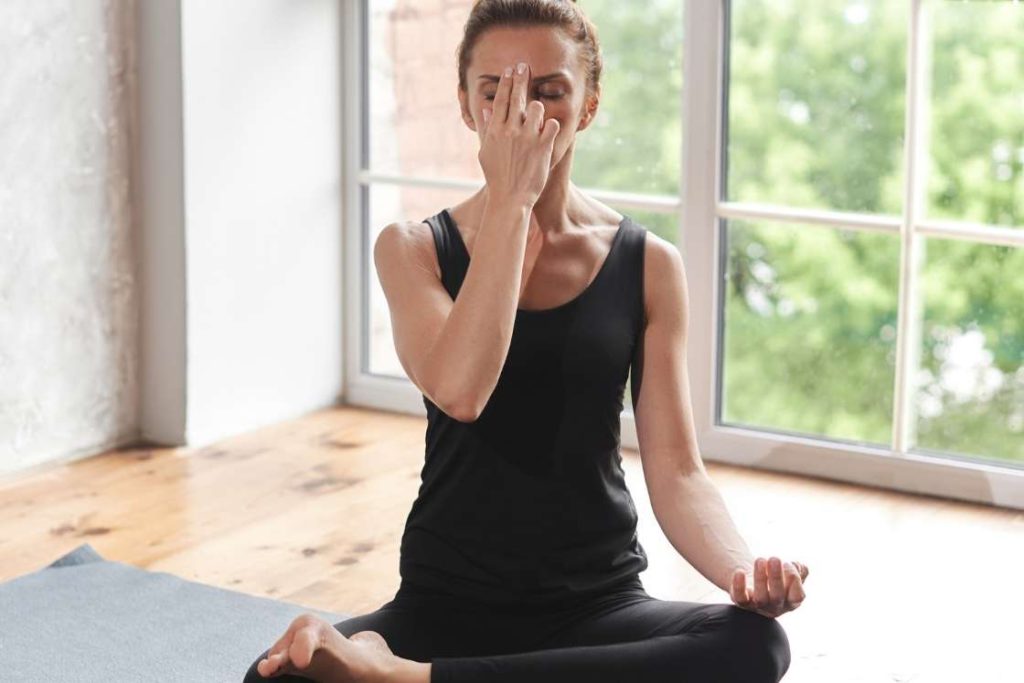 Image: Shutterstock
Image: ShutterstockNadi Shodhana Pranayama, also known as Alternate Nostril Breathing, is particularly beneficial for individuals with Vata dosha imbalances. Vata dosha is associated with qualities such as coldness, dryness, and mobility. Vata imbalances may cause symptoms such as anxiety, restlessness, insomnia, and irregular digestion.
Nadi Shodhana Pranayama helps to balance Vata dosha by calming the mind, reducing anxiety, and promoting relaxation. This pranayama technique involves alternate nostril breathing, which helps to balance the flow of energy in the body, harmonizing the left and right energy channels (Ida and Pingala).
By regularly practicing Nadi Shodhana Pranayama, and Vata Dosha individuals can experience the following benefits:
Calming the Mind: The slow and rhythmic breathing pattern of Nadi Shodhana Pranayama helps calm the mind and reduce excessive mental activity often associated with Vata imbalances.
Balancing the nervous system: This pranayama technique has a calming effect on the nervous system and helps reduce feelings of restlessness and nervousness that are common in people with Vata dosha.
Focus and concentration are strengthened: By balancing the flow of energy in the body, Nadi Shodhana Pranayama improves mental clarity, focus, and concentration, which can be helpful for people with Vata imbalance.
Regulating digestion: Vata imbalances can cause digestive issues like bloating, gas, and irregular bowel movements. Nadi Shodhana Pranayama stimulates the digestive fire (agni) and supports healthy digestion. It increases oxygen supply to the digestive organs, enhances nutrient absorption, and helps regulate bowel movements.
Promoting relaxation and better sleep: By calming the mind and nervous system, Nadi Shodhana Pranayama leads to a state of relaxation that helps people with Vata dosha experience better sleep quality and overcome insomnia.
Steps to practice
Sit with a straight back in Padmasana (lotus pose), Shukhasana (easy pose), or Vajrasana (thunderbolt pose). On your right hand make the Vishnu Mudra – bend the index and middle finger into the palm while the remaining fingers remain comfortably straight. On your left hand, you can make the Gyan mudra and keep the hand on the knee with palms up. Bring your right hand towards your face and place the thumb near the right nostril and the ring and little finger on the left nostril. These fingers will act as a lid for opening and closing the nostrils. Begin the pranayama by closing the right nostril with the thumb and inhaling deeply through the left nostril. Close the left nostril with the middle and little finger and retain the breath inside for a few seconds. Open the right nostril and exhale completely, emptying your lungs. Inhale again from the right nostril, close the nostril while holding in your breath, and release the breath from the left nostril. This completed one round of nadi shodhana. Repeat the process for a minimum of 10 rounds at a time.Ujjayi Pranayama (Victorious Breath)
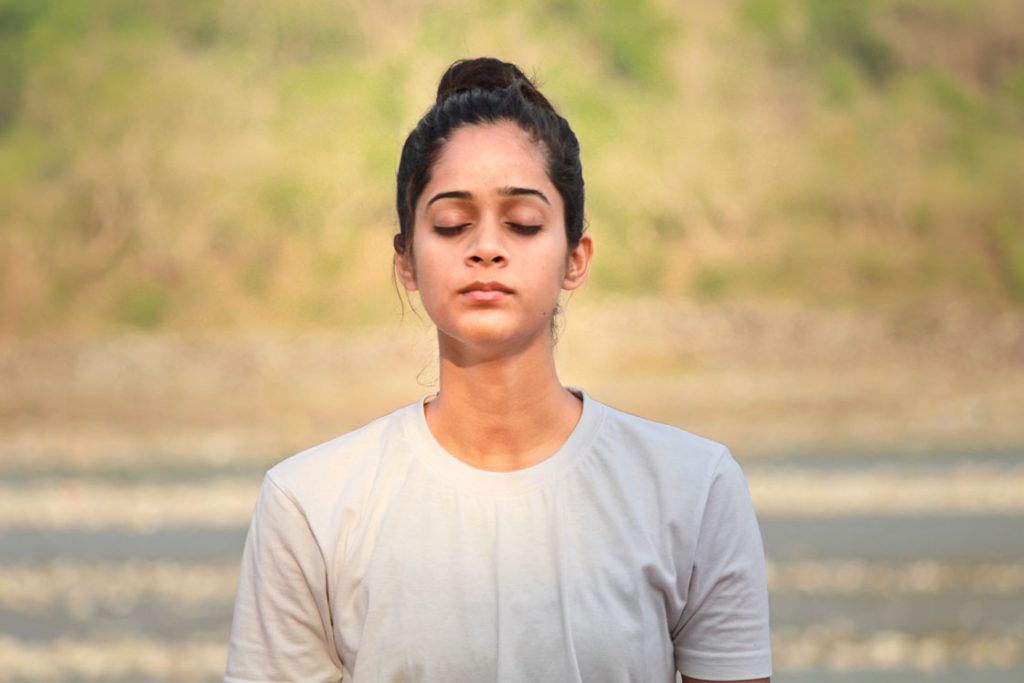
For people with a Vata dosha, who often suffer from restlessness, confusion, and a sense of imbalance, practicing Ujjayi Pranayama can be very helpful. This breathing technique is known for its calming effects and helps to alleviate symptoms and promotes a sense of inner balance. Ujjayi Pranayama not only leads to a deep sense of calm but also improves memory, mental focus and clarity. Incorporate this practice into your routine to experience the beneficial effects it offers to harmonize your vata dosha.
It relieves digestive problems: Ujjayi is also a warming pranayama and can help with digestive problems such as gas and bloating, which are common symptoms of Vata imbalance. By stimulating digestive heat, Ujjayi pranayama can improve digestion and metabolism.
Giving Heat: Ujjayi Pranayama also warms the body, which is very important for Vata individuals as they naturally have cold hands and feet.
Improving skin tone: Vata people tend to have uneven and dull skin tone. Because of the new prana it feeds into the mind and body, this pranayama is also believed to improve skin tone and complexion.
Improves sleep quality: it also deepens the physical and mental experience of rest and relaxation, which is helpful to combat the problem of fatigue, insomnia, less sleep and loss of strength in an imbalanced Vata dosha.
Removes unwanted emotions: Ujjayi Pranayama is highly revered for removing accumulated and unwanted emotions like anxiousness, fear, panic and nervousness from the system through the breathing pattern.
Steps to practice
Sit with a straight back in Padmasana (lotus pose), Shukhasana (easy pose), or Vajrasana (thunderbolt pose). Inhale through your nose while restricting your throat to feel the air as it enters. Your inhalation should sound like snoring. Exhale while keeping your throat tight. When you’ve established a rhythm, breathe in through your nose and out through your open mouth. The throat continues to be tightened. After five to ten rounds of repetition, pause for a minute or two to take deep breaths.Bhramari Pranayama (Bee Breath)
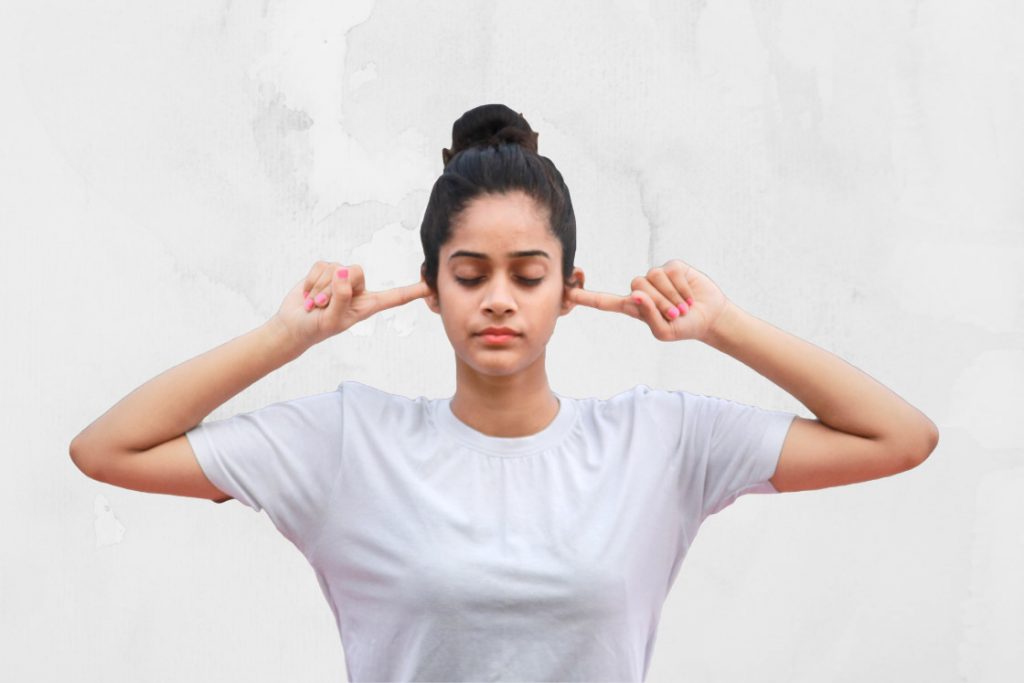 Source: fitsri
Source: fitsriBhramari Pranayama is a special breathing technique that produces a buzzing, bee-like sound in the throat. This practice is known to improve the quality of the voice and strengthen the throat. For people with a Vata dosha, who often suffer from dryness and a hoarse voice, Bhramari Pranayama is particularly effective. By incorporating this technique into your routine, you can experience the beneficial effects it offers. It helps to balance the vata dosha and promote a harmonious state of well-being.
Some other benefits are for vata dosha are:
Nourishes body tissues: Bhramari pranayama is also well known for strengthening and rejuvenating the body tissues as vata people are characterized by dry tissues and crackling joints.
Reduces headaches and migraines: the sound produced by the pranayama is also beneficial in reducing or preventing the onset of headaches and migraines, a common symptom of vata dosha imbalance.
Removes anxiety and tension: Bhramari pranayama is frequently recommended as a way to keep the mind calm, quiet yet attentive. This breathing technique greatly relaxes the body and brain by generating internal vibrations.
Induces sleep: The parasympathetic nervous system is stimulated by the humming sound of this pranayama, which lowers stress, and anxiety while promoting mental calmness. This makes it easier to get to sleep well.
Lowers blood pressure: The humming breath of this pranayama stimulates the nervous system which in turn lowers heart rate and blood pressure.
Tackles digestive problems: Problems related to constipation, dehydration, bloating, and gas can also be curbed by practicing bhramari pranayama regularly.
Steps to practice
Sit with a straight back in Padmasana (lotus pose), Shukhasana (easy pose), or Vajrasana (thunderbolt pose). Maintain a comfortable straight back and a spine-aligned head position. To partially shut the ear, place your index fingers on the tragus, a protruding piece of cartilage on the outside of the ear. You can fold the remaining fingers within your palm. Breathe in via your nose. Your chin should be slightly tucked in (jalandhara bandha), you should push the cartilage of your ears forward to seal them, and you should exhale while creating the sound “hmmmmm” at the back of your throat. Repeat for 5-7 minutes.Kapalbhati Pranayama (Skull Shining Breath)
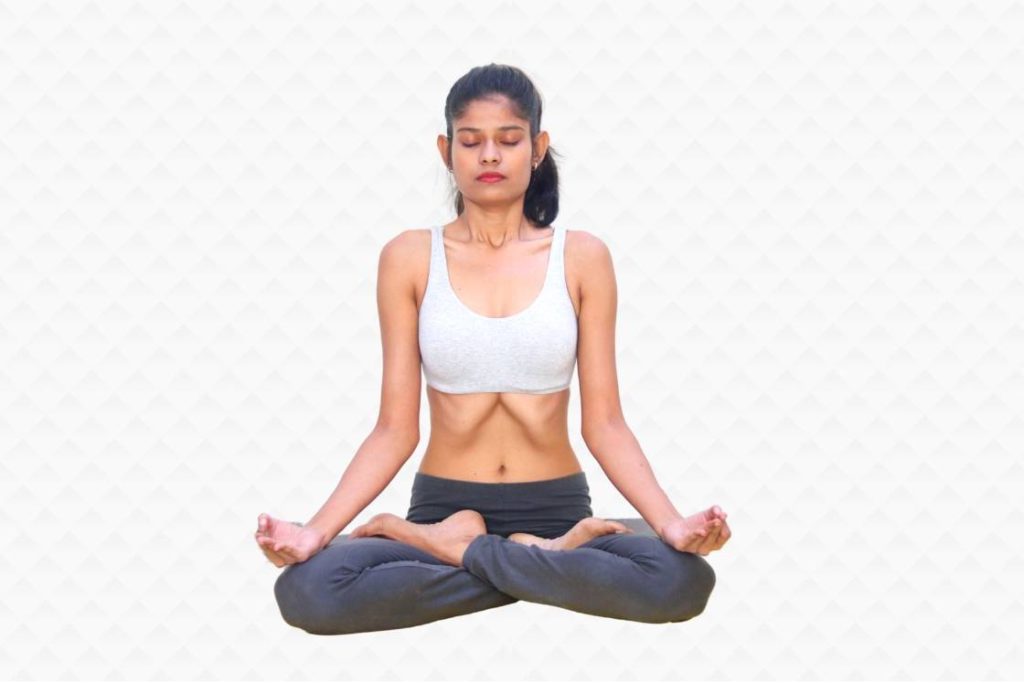 Image Source: fitsri
Image Source: fitsriFor people with a Vata dosha, who often suffer from distractions, lack of concentration, and restlessness, Kapalbhati Pranayama can be of great benefit. This powerful breathing technique reduces mental distractions, promotes alertness, and improves intelligence, memory, and concentration. It also helps maintain a cool brow and provides a sense of balance and calm.
Practicing Kapalbhati Pranayama has other benefits for the Vata dosha:
It tones the abdominal organs: the rapid movement of the abdominal muscles during Kapalbhati stimulates the digestive organs and helps eliminate digestive problems caused by Vata imbalances. Improved blood circulation to the head: Kapalbhati improves blood circulation to the head and relieves symptoms of Vata imbalances such as dizziness, headaches, negative emotions, and mental distractions. Preparation for Meditation: The soothing breathing pattern of Kapalbhati Pranayama calms the nervous system and mind, making it an ideal preparatory exercise for meditation, which can be challenging for the light and agile nature of Vata.By incorporating Kapalbhati Pranayama into your practice, you will be able to better focus, balance the Vata dosha, and experience the many benefits it offers to your overall well-being.
Steps to practice
Sit with a straight back in Padmasana (lotus pose), Shukhasana (easy pose), or Vajrasana (thunderbolt pose). Close your eyes and place your hand on your knees in the Gyan Mudra. Take a deep breath through your nose expanding your stomach. Exhale forcefully and quickly through your nostrils while contracting your abdominal muscles. The inhalation will automatically follow as a response to the empty lungs. This counts as one breath. Start by practicing three to five rounds, and as your pace improves, gradually increase the number of rounds.Pranayama for Pitta Dosha
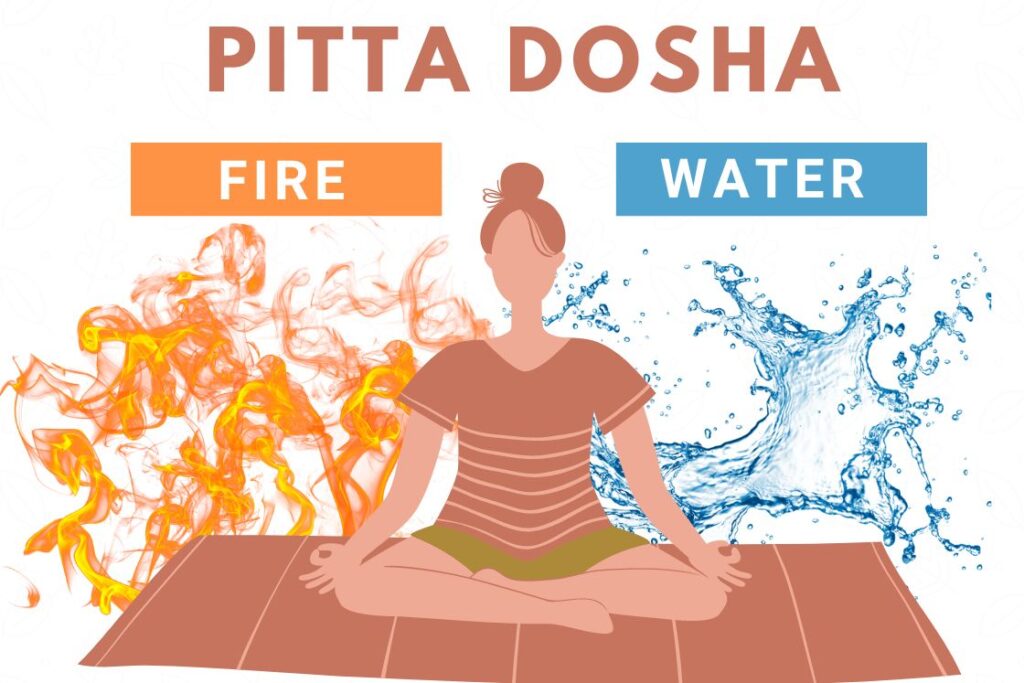
For people with a pitta dosha, characterized by the predominance of the fire and water elements, it is important to focus on pranayama techniques that cool and balance the inherent heat. Pitta dosha controls functions such as digestion, regulation of body temperature, metabolism, mental clarity, decision making and effective communication.
When Pitta is imbalanced, symptoms such as inflammation, fever, hyperacidity, skin rashes and anger can occur. To avoid a further increase in heat, it is recommended to avoid vigorous or heated pranayama exercises. Instead, emphasis should be placed on cooling and relaxing pranayama techniques to balance the pitta dosha.
Also Read: Pitta Body Type: Appearance and Characteristics
The goal of pitta-calming pranayama is to reduce the hot, sharp, and fiery qualities associated with excess pitta and cultivate calming, grounding, and nurturing energy. By incorporating cooling pranayama practices into your routine, you can help rebalance the pitta dosha and alleviate the physical and mental manifestations associated with it.
Shitali Pranayama (Cooling Breath)
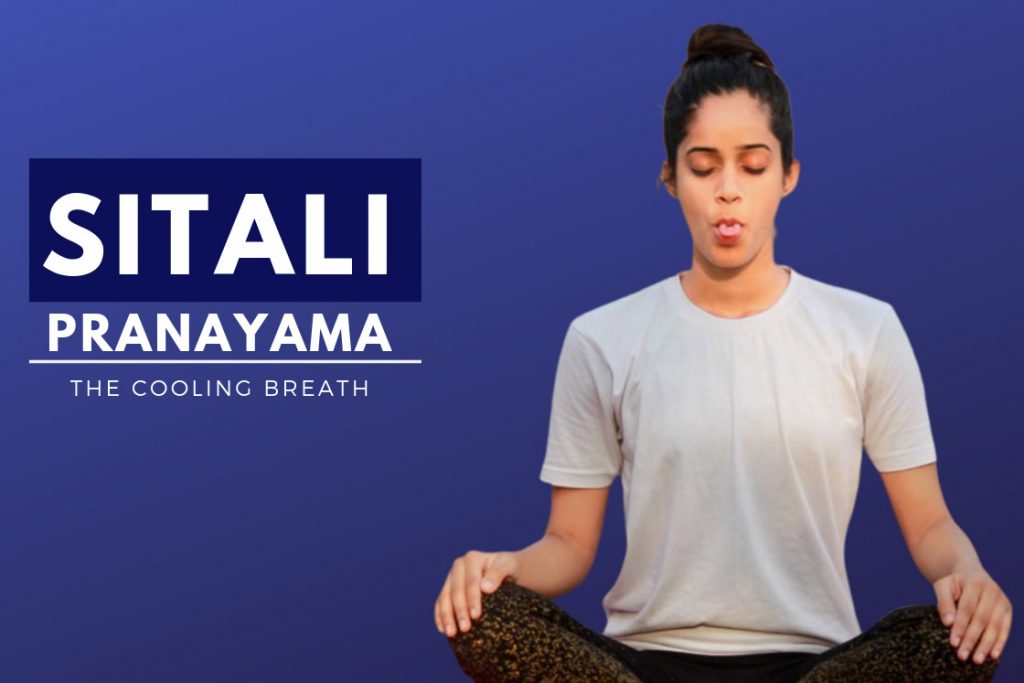
Shitali Pranayama, also known as the Cooling Breath, is a powerful technique to restore the balance of excessive Pitta dosha and cool the body. This practice can effectively combat the heat associated with a Pitta imbalance.
Some additional benefits of Shitali Pranayama for Pitta dosha include:
Balancing digestive fire: The cooling breath of Shitali Pranayama helps reduce heartburn, hyperacidity, and ulcers, promoting proper digestion and thus supporting a healthy appetite. Reducing Inflammation: By mitigating excessive pitta heat, Shitali Pranayama helps reduce inflammation, including joint pain and related problems. Maintaining body temperature: inhaling the cooling breath through the curled tongue helps balance the hot quality of the pitta dosha, maintaining a regulated body temperature. Relieving excessive thirst: Shitali Pranayama balances the water element and adds moisture to the system, helping to relieve the constant thirst associated with a Pitta imbalance.Incorporating Shitali Pranayama into your practice can be an effective way to balance pitta dosha, promote overall well-being, and restore a sense of inner calm and harmony.
Steps to practice
Sit with a straight back in Padmasana (lotus pose), Shukhasana (easy pose), or Vajrasana (thunderbolt pose). Imagine holding a straw in your mouth by forming an ‘O’ shape. Your tongue should be curved at the sides and just barely extend from your mouth. Alternatively, if you are unable to roll it, it can stay flat. Inhale deeply and allow the chilly air to run through your mouth and throat as if you were sucking through a straw. With your mouth closed and your tongue inside, slowly exhale through your nose to let the warm air out. Practice this pranayama 5-10 times in one sitting.Sheetkari Pranayama (Hissing Breath)
The benefits of sheetkari pranayama are the same as shitali pranayama but it comes with a minor difference in the way it is performed.
Gently bring your teeth together and touch the tip of the tongue behind the teeth. As you take in your breath, your lips should be slightly opened which induces the hissing sound of the pranayama.
Bhastrika Pranayama (Bellows Breath)
 © Fitsri
© FitsriBhastrika pranayama, also known as bellows breathing, is a useful technique for rebalancing unbalanced pitta dosha. This practice helps revitalize the digestive system by eliminating toxins and igniting the digestive fire.
Other benefits of Bhastrika Pranayama for Pitta dosha are as follows:
Digestive System Support: Bhastrika Pranayama helps restore proper digestive system function by eliminating toxins and promoting healthy digestion. It can be especially helpful when pitta is unbalanced and causing digestive problems. Mental preparation for meditation: by reducing mental chaos and chatter, Bhastrika Pranayama creates a sense of peace and calm. This prepares the mind for meditation, reducing instability and balancing the mobile nature of pitta. Gentle practice for excessive pitta: For excessive pitta, it is important to perform Bhastrika Pranayama gently. This gentle approach helps prevent pitta from rising further and also helps maintain healthy blood pressure.Incorporating Bhastrika Pranayama into your practice with care and moderation can help rebalance the Pitta dosha, promote a healthy digestive system, and create a harmonious state of mind. Remember to consult a qualified teacher to ensure proper guidance and alignment with your specific needs.
Steps to practice
Sit with a straight back in Padmasana (lotus pose), Shukhasana (easy pose), or Vajrasana (thunderbolt pose). Take a deep forceful inhale as your abdomen and chest rise and exhale with equal force and length, contracting your abdomen. You also have the option to move your arms up and down as you inhale and exhale respectively. Continue to perform such inhale and exhale for a minimum of 5 rounds (1 round = 1 full breath). Take a short break while breathing normally before starting another round.Chandra Bhedana (Moon-Piercing Breath)
 Image: Canva
Image: CanvaChandra Bhedana, also known as Moon-Piercing Breath, is a pranayama technique that harnesses the cooling energy of the moon to balance the excessive heat associated with pitta dosha.
The benefits of Chandra Bhedana for Pitta dosha include:
Relieves headaches: by calming the cranial nerves, Chandra Bhedana can help reduce and prevent burning headaches that are common with Pitta imbalances. Promotes healthy digestion: the cooling effect of this pranayama supports digestive fire and helps reduce problems such as belching, hyperacidity, acid regurgitation and flatulence. Calms the nervous system: Chandra Bhedana activates the parasympathetic nervous system and addresses imbalances related to Pitta, such as emotional instability, hormonal imbalances and inflammation.By directing the breath through the left nostril, which corresponds to the cooling lunar energy, Chandra Bhedana helps restore balance and harmony to the Pitta dosha. As with any pranayama practice, it is recommended to learn and practice it under the guidance of a qualified teacher to ensure proper technique and alignment with individual needs.
Steps to practice
Sit with a straight back in Padmasana (lotus pose), Shukhasana (easy pose), or Vajrasana (thunderbolt pose). On your right hand make the Vishnu Mudra and on your left hand, make the gyan mudra and keep the hand on the knee with palms up. Bring your right hand towards your face and place the thumb near the right nostril and the ring and little finger on the left nostril. Close the right nostril with the ring and little finger and inhale from the left nostril. Now close the left nostril with your thumb and retain the breath for a few seconds. Open the right nostril and exhale fully. Repeat the same process for at least 6-7 times.Pranayama for Kapha Dosha
In the kapha dosha, which is characterized by a combination of earth and water elements, qualities such as heaviness, stickiness, dampness, and coolness predominate. This dosha plays an important role in maintaining body lubrication, stability, and structural integrity of bones, muscles, and fat cells.
However, an imbalance of Kapha can lead to various problems such as weight gain, lethargy, drowsiness, swelling, loss of appetite, congestion, coughing, and even depression.
To balance the slow, heavy, cool, and damp nature of Kapha, it is recommended to practice pranayama techniques that are fast, light, warm, and drying. Since Kapha is primarily associated with the water element, increasing internal fire through pranayama is particularly beneficial. This not only optimizes digestion but also boosts energy for daily activities.
Effective pranayama practices for increasing internal fire and balancing Kapha include kapalabhati (skull shining breath), bhastrika (bellows breath), sun breath (Surya Bhedana Pranayama), and ujjayi (victory breath). Practicing these techniques for a few minutes can warm up the body, energize the system and improve circulation.
Incorporating these inner fire-stimulating pranayamas into your routine can support a healthy balance of kapha, improve digestion and maintain vitality. It is important to practice pranayama under the guidance of a qualified teacher and to adapt the techniques to your individual needs and abilities.
Kapalbhati Pranayama (Skull Shining Breath)
 Image Source: fitsri
Image Source: fitsriKapalbhati Pranayama is a powerful practice that brings warmth and vitality to the cold and stagnant qualities of Kapha Dosha. By stimulating circulation, it helps to awaken and invigorate the system and dispel feelings of sluggishness, melancholy, and lack of inspiration that accompany a Kapha imbalance.
This dynamic pranayama technique not only increases energy levels but also relieves typical Kapha symptoms such as drowsiness, lethargy, and feelings of heaviness. It strengthens the immune system and provides protection against allergies and coughs.
In addition, Kapalbhati aids in weight loss by stimulating the abdominal muscles through vigorous contraction and expansion. It also strengthens the digestive fire and helps with slow digestion and loss of appetite, which are common in Kapha individuals.
Incorporating Kapalbhati Pranayama into your practice can help balance Kapha dosha, improve vitality, and promote overall well-being. It is advisable to learn and practice Kapalbhati Pranayama under the guidance of a qualified teacher to ensure proper technique and safe application.
Steps to practice
Sit with a straight back in Padmasana (lotus pose), Shukhasana (easy pose), or Vajrasana (thunderbolt pose). Close your eyes and place your hand on your knees in the mudra of your choice—preferably the Gyan Mudra. Focus on your abdominal area, take a deep breath through your nose, and feel your belly expand. Exhale vigorously through your nostrils while contracting your abdominal muscles. The inhalation will automatically follow as a response to the empty lungs. This counts as one kapalbhati breath. A kapalbhati round consists of 20 breaths. Start by practicing three to five rounds, and as your pace improves, gradually increase the number of rounds.Bhastrika Pranayama (Bellows Breath)
Bhastrika Pranayama is a dynamic breathing technique that generates body heat and eliminates excess Kapha energy. Kapha individuals often feel sleepy, congested, and unmotivated when their kapha is imbalanced. Bhastrika can be very beneficial as it fills the energy channels with revitalizing prana.
In addition, this pranayama activates the parasympathetic nervous system, which promotes the reduction of stress and anxiety. Its energizing and warming properties help balance the water element of kapha dosha, treating problems such as water retention, swelling, and chills associated with Kapha imbalance.
Bhastrika Pranayama is also known to improve metabolism and can help alleviate various diseases caused by a Kapha imbalance.
It is important to learn and practice Bhastrika under the guidance of a qualified teacher to ensure proper technique and safety. Incorporating this pranayama into your routine can help balance kapha dosha, increase energy levels, and promote overall well-being.
Steps to practice
Sit with a straight back in Padmasana (lotus pose), Shukhasana (easy pose), or Vajrasana (thunderbolt pose). Take a deep forceful inhale as your abdomen and chest rise and exhale with equal force and length, contracting your abdomen. You also have the option to move your arms up and down as you inhale and exhale respectively. Continue to perform such inhale and exhale for a minimum of 5 rounds (1 round = 1 full breath). Take a short break while breathing normally before starting another round.Surya Bhedana (Sun-Piercing Breath)
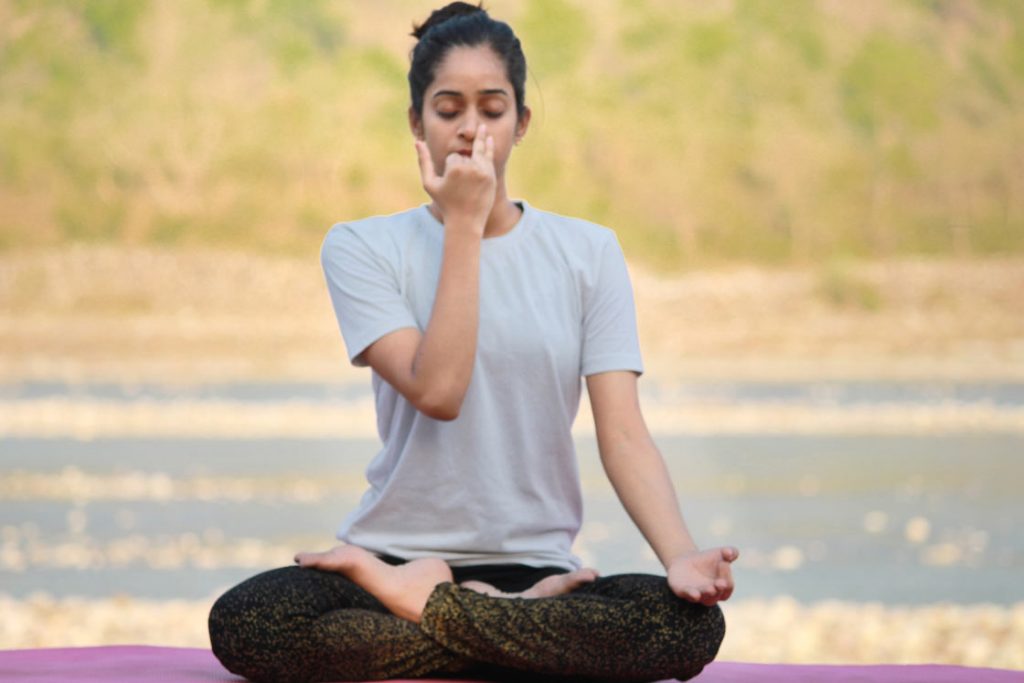 Inhaling Through Right Nostril in Surya Bhedana
Inhaling Through Right Nostril in Surya BhedanaSurya Bhedana Pranayama focuses on using only the right nostril for inhalation to generate internal heat and balance the water element of Kapha dosha. By increasing heat, this pranayama helps balance the cool and moist qualities associated with Kapha dosha.
The increase in internal heat from Surya Bhedana Pranayama improves digestion and promotes weight loss, which addresses two common manifestations of Kapha imbalance. In addition, deep breathing in this practice improves lung capacity and helps with asthma, which is common in Kapha individuals.
This pranayama can be beneficial in treating various problems associated with kapha imbalance, such as excessive sleep, loss of vitality, decreased arousal, and lack of motivation. It can also help alleviate symptoms of depression. In addition, Surya Bhedana Pranayama energizes and stimulates the body and reduces the feeling of sluggishness and heaviness associated with Kapha Dosha.
It is important to practice Surya Bhedana Pranayama under the guidance of a qualified teacher to ensure proper technique and safety. By incorporating this pranayama into your routine, you can support the balance of kapha dosha, invigorate the body and promote overall well-being.
Steps to practice
Sit with a straight back in Padmasana (lotus pose), Shukhasana (easy pose), or Vajrasana (thunderbolt pose). On your right hand make the Vishnu Mudra – bend the index and middle finger into the palm while the remaining fingers remain comfortably straight. On your left hand, you can make the gyan mudra and keep the hand on the knee with palms up. Bring your right hand towards your face and place the thumb near the right nostril and the ring and little finger on the left nostril. These fingers will act as a lid for opening and closing the nostrils. Close the left nostril with the ring and little finger and inhale from the right nostril. Now close the right nostril with your thumb and retain the breath for a few seconds. Open the left nostril and exhale fully. Repeat the same process for at least 6-7 times in one sitting.Ujjayi Pranayama (Victorious Breath)
Ujjayi pranayama is an effective practice for treating symptoms of Kapha imbalance such as feelings of heaviness, excessive sleep, sluggishness, and sleepiness. By practicing Ujjayi Pranayama, energy circulation is improved, leading to greater vitality and alertness.
One of the most important benefits of Ujjayi Pranayama for Kapha dosha is its ability to increase the internal heat of the body. This helps to balance the moist and fluid properties of kapha and provides a balance of fluids in the tissues. Especially during the cold season, Ujjayi Pranayama can help prevent colds and coughs that are common in Kapha individuals.
In addition to the physical effects, Ujjayi Pranayama also has a positive influence on the mind and emotions. Kapha individuals often experience extreme emotions such as greed, sadness, ignorance, and possessiveness. Ujjayi Pranayama promotes mental clarity and the release of pent-up emotions, offering relief from negative feelings and emotional imbalance.
To practice Ujjayi Pranayama, it is recommended to sit in a comfortable position, relax the body and focus on breathing slowly and deeply through the nostrils while gently contracting the back of the throat. This creates a soft, whispering sound during both inhalation and exhalation. It is important to practice under the guidance of a qualified instructor to ensure proper technique and to adapt the exercise to individual needs.
Incorporating Ujjayi Pranayama into your routine can help balance kapha dosha, increase energy, promote mental clarity, and bring a sense of lightness and aliveness to your being.
Steps to practice
Sit with a straight back in Padmasana (lotus pose), Shukhasana (easy pose), or Vajrasana (thunderbolt pose). Inhale through your nose while restricting your throat to feel the air as it enters. Your inhalation should sound like snoring. Exhale while keeping your throat tight. When you’ve established a rhythm, breathe in through your nose and out through your open mouth. The throat continues to be tightened. After five to ten rounds of repetition, pause for a minute or two to take deep breaths.Nadi Shodhana (Alternate Nostril Breathing)
Nadi Shodhana, also known as alternate breathing, can improve digestive system function when practiced along with yoga postures, which is especially beneficial for kapha individuals who often have digestive problems. It promotes a fresh flow of prana, increases energy levels, and counteracts the lethargy and sluggishness associated with a Kapha imbalance.
This practice balances the left and right hemispheres of the brain and balances emotions and creativity in Kapha dosha. It also stimulates and optimizes the function of the endocrine glands, counteracting hormonal imbalances that Kapha individuals often face. By cleansing the nadis, Nadi Shodhana can also alleviate allergic problems.
Steps to practice
Sit with a straight back in Padmasana (lotus pose), Shukhasana (easy pose), or Vajrasana (thunderbolt pose). On your right hand make the Vishnu Mudra – bend the index and middle finger into the palm while the remaining fingers remain comfortably straight. You can make the gyan mudra on your left hand and keep the hand on the knee with palms up. Now bring your right hand towards your face and place the thumb near the right nostril and the ring and little finger on the left nostril. These fingers will act as a lid for opening and closing the nostrils. Begin the pranayama by closing the right nostril with the thumb and inhaling deeply through the left nostril. Close the left nostril with the middle and little finger and retain the breath inside for a few seconds. Open the right nostril and exhale completely, emptying your lungs. Inhale again from the right nostril, close the nostril while holding in your breath, and release the breath from the left nostril. This completed one round of nadi shodhana. Repeat the process for a minimum of 10 rounds at a time.Tips for practicing pranayama for doshas
When practicing pranayama for doshas, you should usually do it early in the morning, preferably at sunrise. Most pranayama techniques increase energy, so they are helpful in maintaining energy and concentration throughout the day. It is important to consider the peak times of each dosha. For example, the Vata dosha peaks twice a day, from 2 to 6 am and from 2 to 6 pm.
The morning time, known as Brahma Mahurta, is ideal for any yoga practice because it allows for a fresh supply of oxygen and a calm environment. In the evening, focus on rejuvenation and winding down. Choose a pranayama that suits your physical and mental energy levels. Also, consider the seasons. In summer, be careful with pranayama techniques that increase internal heat so as not to upset the pitta balance.
Conversely, in winter, avoid pranayama with cooling properties unless you have a fever. To make pranayama a daily habit, choose a time that is most comfortable for you, be it in the morning or evening. Set aside at least 5 minutes for your practice. Once you feel the benefits, you may want to increase the time you spend on it and try more pranayama techniques.
Conclusion
While the above list of pranayama techniques is not exhaustive, they are some of the most recommended exercises to balance each dosha. You can start by practicing one or two techniques at a time and gradually build up a combination of exercises that best suits your dosha.

 JaneWalter
JaneWalter 































